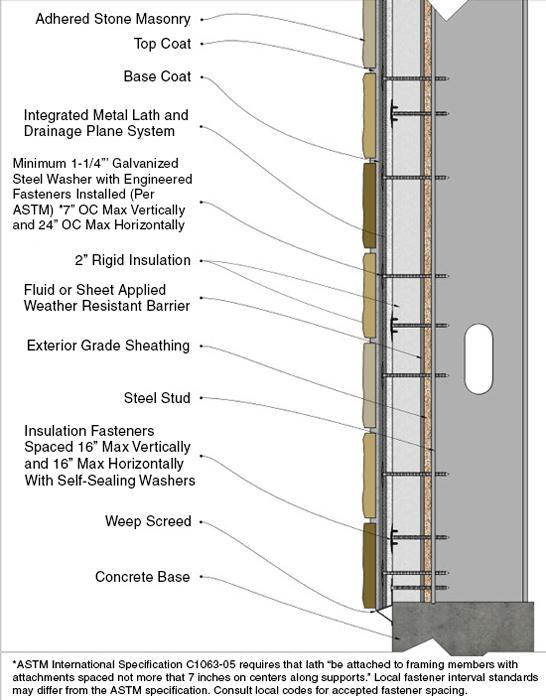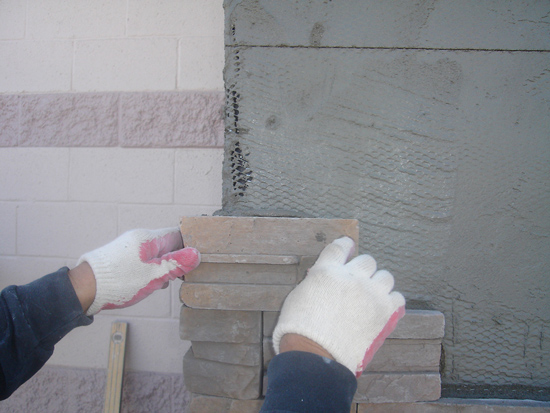Designing Adhered Masonry Veneer
Proper Adhered Masonry Wall Design
Adhered masonry walls using veneers such as thin brick, thin stone, and stucco have been in use for decades. A traditional adhered masonry system includes a substrate with one or two layers of a weather resistant barrier (WRB) on the substrate’s outside face, a metal lath securely fastened to the substrate, a “scratch” or base mortar coat that completely encapsulates the metal lath, a top mortar coat, and a masonry veneer adhered by a top coat to the scratch coat. Stucco veneers may also include a “brown” mortar coat over the scratch coat and a “color” mortar coat over the brown coat, which is the final stucco finish.

Image courtesy of Mortar Net Solutions
Adhered masonry veneer wall detail with drainage mesh
Like a masonry cavity wall, a high-quality adhered masonry wall is designed with the expectation that moisture will penetrate the veneer and consists of multiple components that act together to provide structural integrity combined with proper drainage and drying. Traditional adhered masonry veneer walls have relied on double layers of weather resistant barriers (WRBs) and self-furring metal lath to provide drainage and drying, along with batt, foam, or rigid insulation between studs for insulation. In concrete masonry unit (CMU) structural walls, insulation may be provided by filling the CMU cells with insulation or by furring out the interior and using batt, foam, or rigid insulation. However, demand for more sustainable and energy-efficient walls combined with advances in building science have led to a number of important design improvements during the past few years, including the addition of weep screeds, location of rigid insulation (RI) between the veneer and the structural wall, and a drainage plane behind the lath.
A weep screed is placed at the bottom of the wall before the lath is installed to allow drainage of moisture that makes its way down the wall between the base coat and WRB. A weep screed is highly recommended but is not always required by code. Modern building science and increasingly stringent energy codes are recommending or requiring the addition of rigid insulation (RI) and a drainage plane between the substrate and the lath. These additions make designs more challenging but pay off with longer building life, and greater energy efficiency and occupant comfort.
Every adhered masonry veneer wall must start with a dry, sound substrate—a wood or steel stud wall with sheathing or a CMU wall. Unlike masonry cavity walls in which the masonry veneer rests on a brick ledge designed to support its weight, adhered masonry veneer is suspended from the structural wall, so a wet, unsound structural wall will prevent solid anchoring of the metal lath and result in veneer failure.
The most commonly used method for keeping the structural wall dry is the installation of either a WRB or an air and vapor barrier applied to the surface of the substrate. WRBs can be sheet material or liquid applied, and the substrate must be dry and free of any contaminants that could interfere with their application. In this course, we will concentrate on sheet product WRB installation without going into liquid- or sheet-applied air and vapor barriers. In many geographical areas local codes require the use of two layers of WRB, which can be asphalt impregnated paper or “housewrap,” a generic term for manufactured WRBs with varying degrees of permeability. On stud wall buildings, the first WRB layer is typically installed by the carpenters who frame the walls as a way to keep the sheathing dry until the adhered masonry veneer installers arrive and install the second layer. On CMU walls, the WRB may be installed by the masons or by a separate WRB contractor.
The second layer of sheet product WRB has several functions: it keeps the first WRB layer dry, it adds to the protection of the exterior walls during the application of the base mortar coat, and it serves as a bond break between the base coat and the first layer of WRB. A bond break is extremely important because it allows thermally generated movement in the veneer relative to the substrate so the building can move without cracking the veneer. There are a number of variations in WRB requirements, which are dependent on several factors, including code enforcement, insulation use and placement, local climate, and cost. These variations are beyond the scope of this course, but the Masonry Veneer Manufacturers Association (MVMA) can provide further information and guidance.
Lath is installed over the WRB by the veneer installers. If continuous rigid insulation (RI) is specified, the lath is attached on top of the insulation. If a drainage plane is specified, it is installed between the lath and RI or WRB. Wire lath, metal lath, 2.5-pound lath, and 3.4-pound lath are all the same basic product—expanded galvanized metal lath. Galvanizing is the application of a zinc coating to the metal lath. It prevents corrosion and is expressed as the weight of zinc in tenths of an ounce that is applied per square foot of lath, so G-60 lath, the most common galvanizing standard, has an average of 0.60 ounces of zinc evenly applied to every square foot. Lath with less than a G-60 galvanizing rating should not be used.
Lath is installed by placing it against the WRB and fastening it every 6 inches vertically into a stud and horizontally into structural members. Fasteners should not be placed between the studs because they will work loose as the building moves and can create paths for water and air to pass through the wall. Once the lath is in place, the wall is ready for the “scratch” or base coat of mortar. A minimum ½-inch-thick base mortar coat is forced into the lath so it completely encapsulates the lath, then the masonry veneer is attached to the base coat with a mortar top coat. The combined base and top coat thickness should be about 1 inch.

Photo courtesy of Mortar Net Solutions
Typical adhered masonry
Adhered masonry veneers typically consist of natural stone cut into thin sections, thin brick (masonry brick units sawn into thin sections), cultured stone (cast concrete units that look like natural stone), and stucco. In typical adhered masonry construction without a drainage plane, walls dry primarily due to the moisture escaping between the units, either through mortar joints or open joints, or through evaporation through stucco. Without a drainage plane, this is a slow process.
Walls dry at different rates, but a good rule of thumb is to expect a completely saturated wall with no drainage plane to dry at a rate of 1 inch of material thickness every 40 days. Actual drying rate depends on temperature, wind and sun exposure, density of the mortar coats, time of dry weather exposure, and whether or not a weep screed and drainage plane have been installed. While the base mortar coat is wet, moisture can penetrate fastener holes and create a damp substrate wall in concentrated areas around those holes, which can lead to substrate deterioration and mold growth if the substrate can not dry quickly. In worst-case scenarios, water can cause damage to the interior walls and dramatically reduce the effectiveness of batt insulation.
Properly designed cavity walls provide rapid drainage and drying by including a space between the veneer and substrate that allows moisture to move rapidly out of the cavity and air to circulate in the cavity. Modern adhered masonry veneer walls also incorporate a space that serves the same function in the form of an entangled or high loft non-woven drainage mesh made of polyester or polypropylene between the WRB and the base coat.
Both materials prevent mortar from entering the drainage space, allow air, vapor, and water to move unrestricted behind the base coat, and allow for full encapsulation of mortar around the wire lath. Substrate walls remain dryer because moisture will quickly run down the WRB and out of the weep screed or evaporate due to air movement within the mesh. The base and top coats will also cure faster with a drainage mesh because air is able to reach both sides of the mortar. The result is a system that will not exhibit mortar deterioration in wet conditions, and which will maintain a strong bond between masonry units and the base coat.
Several years of testing have convinced the MVMA to allow the reduction of two layers of WRB to only one when drainage mesh is installed because the drainage mesh acts as a bond break, and prevents the base mortar coat from coming in contact with the first WRB layer and transferring moisture to the substrate. However, local code officials have the final word in this issue so be sure to check with them before specifying a single-layer of WRB.
Drainage mesh systems are available in two forms: as metal lath and drainage mesh installed separately on site, or as a systemized product with the lath and mesh attached to each other in a factory. Both configurations are attached to the wall in the same way using the same fastener types, but the systemized product saves labor and reduces the number of wall penetrations because the lath and drainage mesh are installed at the same time with only one set of fasteners, and because frequently only a single layer of WRB is necessary.
Lath installation is usually specified to conform at minimum to ASTM C-847, which describes recommended installation procedures for expanded metal lath. ASTM International is a standards organization that develops and publishes voluntary consensus technical standards for a wide range of materials, products, systems, and services. ASTM C-847 and most local codes require that metal lath sections overlap by a minimum of 1 inch, and installing lath and mesh separately or as a system can meet this requirement. However, the lath/drainage system includes a built-in overlap determined by a holdback of the drainage mesh on two edges that makes it easier for installers to create the conforming overlap. The mesh sections can be overlapped if installed separately from the lath, or will be abutted if installed as a factory-assembled system to create a continuous drainage plane behind all the areas covered with lath.









